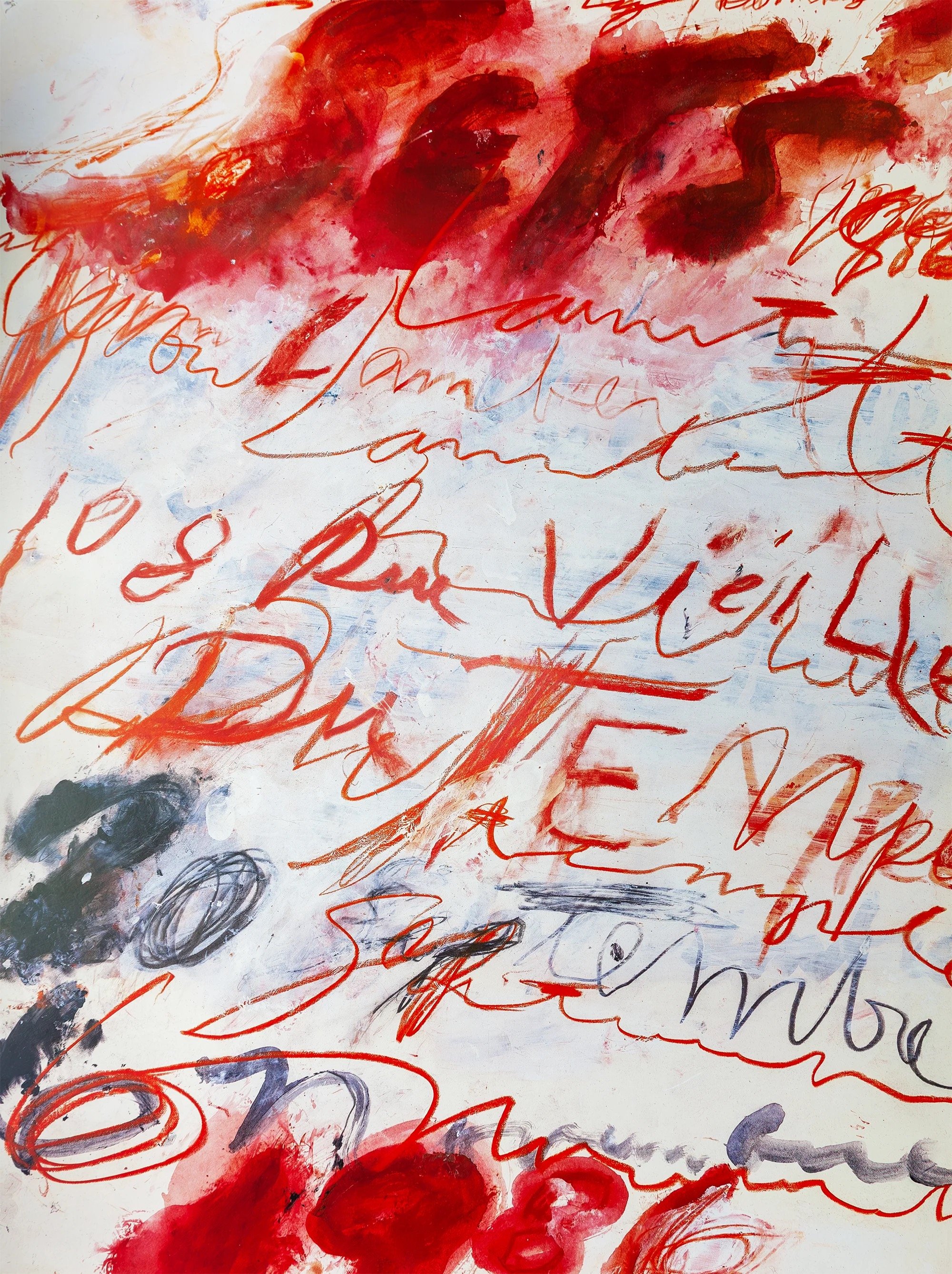Cycles and Seasons - Cy Twombly. Essay by Tacita Dean
A Panegyric, essay by Tacita Dean. (Panegyric = a public speech or published text in praise of someone or something).
(I also listened to the audio recording of the lecture Tacita Dean gave at the Dia Centre in NY.)
Pan - horned, hairy, half-goat god of nature who embodies the spirit of the landscape and the excitement that it inspires in us (and Cy Twombly). The feeling of alarm one gets in the forest is said to be due to Pan walking beside you, that creeping anxiety, mixed feeling of exuberance and awe, - his manic, frenzied presence, that can inspire fear - ‘panic’ comes from Pan. Ancient Greeks perceived Pan in nature.
Hans Ulrich Obrist interview with Twombly - CT wanted to talk about poetry, not his work. Concerned that poetry disappearing from our cultural consciousness. No one recalled poetry by line, by rote. This concerned CT. He had started buying up old manuscripts.
TAKE AWAY: My reflection is that when we think of CT’s text and classical references, these concerns of his make sense. The inclusion of word and names of the ancient gods, carry with them the myths and legends. Similar to my interest in Penelope and her weaving and unravelling. The stories may be old by they are continually referenced. Still play a major role in our communication, literature, poetry, political speeches and advertising. Twombly is recorded saying that “I never really separated painting and literature because I’ve always used reference.” Having studied English Literature at University, I am keen to reference what I have read and am currently reading, whether it is fiction, lyrics, or other sources.
TD: talks about James Joyce and his method of crossing out and writing over, which she compares to CT’s similar tactic. Writing over text, drawing over drawings. Joyce, used different coloured crayon and each colour had its own meaning. Part of his own ‘transfer cipher’.
“Both men erase to make a mark. Twombly crosses out as a way of making the surface work: his rubbing out is a process of adding as well as subtracting: a build up of cancellation when the connection has broken, marking to say and then not to say: retraction that leaves a trace, because what Twombly is working on, and working out, is HOW TO MAKE A PAINTING.” p35
TAKE AWAY: The idea of erasing to make a mark is exciting as it is something that relates to how I like to work with a process of layering and subtracting. ‘A build up of cancellation’ - the unravelling of thread and the remnants of stitches unpicked. A trace element left behind. The workings out, mistakes and all, laid bare.
TD: she talks about how erasure has become normal, in the sense of cancelling out previous mediums. ‘Cancellation without a trace’ - digital over celluloid, and analogue companions, IT’S CLEANING UP OUR WRITTEN WORLD. Soon handwriting with be the oddest of activities.
“No one shows their mistakes anymore, the development of their thinking across the page. Everything appears in the world as unconditional and without doubt: no waver here, no lapse of concentration there: no fissure in which to peer through and see the humanity inside.” p35
TAKE AWAY: This idea of showing mistakes, rubbing out, blurring of detail, the run of dye, the scribbles, the wayward sewing machine line. The fissure in which to show our humanity. The moment at which we are about to unravel, to unpick the pattern within.
TD: His handwriting (CT’s), is the familiar integrant to his images: it is homely and hausgemacht (homemade), like the note left on the table, telling us of the actual presence beyond the nib of beyond the lead; his human presence encountering the larger world and our universal anguish. p36 (NB: Isabelle Graw and the artist’s presence, the mark)
TD: in Greek, grapho means to write, but zographo means to draw or paint. Z0-grapho literally means, writing life.
For Twombly, to name is to evoke an extra-ordinary life, one well-acknowledged. The names with which he communicates have already been communicated through the words of the poets: Homer, Virgil, Shelley etc. She think that CT communicates an absolute connection with the past through the name and all that it resonates. an ‘unequivocally emotional connection’. MAYBE TWOMBLY IS CLOSER TO HIS POETS THAN OTHER PAINTERS?
TD: It is wrong to relate Twombly’s marks to doodling; they come from mindfulness rather than mindlessness and are NOT THE MARKS OF AN UNCONSCIOUS MIND BUT A KNOWING ONE. He has not relinquished his aesthetic control but he is working from the enviable state of just below his deliberate mind, where he is no longer self-conscious or pre-imaginative. Although different, his work is more reminiscent of graffiti. Twombly says he is more interested in the surface than the materials. NB: Graffiti’s desire to leave a mark. The essence of life inscribed - a name in stone.
NB: the bleaching of the ‘classical world’ by the sun from the ‘gaudy places full of brightly painted temples and high coloured statues’, bleached of all impurities and aesthetically acceptable. Twombly’s paintings are predominantly white.
TAKE AWAYS: The bleaching of the past, the white-out. I also like to translate this to the use of unprimed canvas, introducing the rawness, the un-prepared. Going back to the organic aesthetic of the canvas, and the back face of the canvas with the stained dye showing through - at the same time showing ageing, and also the bi-product, the uncontrolled, the mistake.



